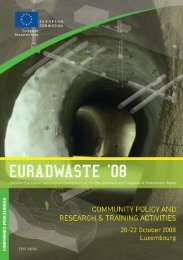EU industrial structure - EU Bookshop - Europa
EU industrial structure - EU Bookshop - Europa
EU industrial structure - EU Bookshop - Europa
Create successful ePaper yourself
Turn your PDF publications into a flip-book with our unique Google optimized e-Paper software.
definition of shocks. Shocks, or disturbances, are often<br />
defined as significant changes in variables from underlying<br />
trends. The magnitude of changes is in general determined<br />
using measures of dispersion such as standard deviations.<br />
Shocks could also be defined as unexpected events beyond<br />
the control of industries or the entity in question. See for<br />
example the discussion in Varangis et al. (2004).<br />
Four two‑industry VAR‑models were estimated, consisting<br />
of four variables: labour productivity and employment for<br />
the motor vehicles industry and for one of the other four<br />
industries respectively. 40<br />
Impulse response functions were calculated in order to see<br />
the responses of technology and non‑technology shocks<br />
40 The models are estimated in first differences of the variables since<br />
unit root tests indicated that they were non-stationary. See http://<br />
ec.europa.eu/enterprise/newsroom/cf/_getdocument.cfm?doc_<br />
id=6003 for a detailed description of the methodology and results.<br />
Chapter II — Changes in <strong>EU</strong> Industrial <strong>structure</strong><br />
on employment and productivity growth. The impulse<br />
response functions show how, for example, employment<br />
in the rubber and plastics industries responds to<br />
a one‑percentage technology shock in the motor vehicles<br />
industry. The responses are presented for a time period of<br />
four years (48) months. The responses are shown together<br />
with 90 percent confidence intervals.<br />
The analyses show that a one‑percentage technology shock<br />
originating in the motor vehicles industry has significant<br />
positive and permanent effects on employment in the<br />
rubber and plastics industry, which increases by some 2.5 %.<br />
Productivity in the rubber and plastics industry increases<br />
permanently by some 1.5 % after a technology shock in the<br />
motor vehicles industry, cf. Figure II. 9.<br />
FIgURE II.9: A technology shock in the motor vehicle industry has permanent effects on employment<br />
and productivity in rubber and plastics<br />
Employment productivity<br />
4.5<br />
4.0<br />
3.5<br />
3.0<br />
2.5<br />
2.0<br />
1.5<br />
1.0<br />
0.5<br />
0.0<br />
-0.5<br />
-1.0<br />
lower<br />
upper<br />
response<br />
1<br />
13<br />
25<br />
Source: own calculations using Eurostat data.<br />
37<br />
48<br />
3.5<br />
3.0<br />
2.5<br />
2.0<br />
1.5<br />
1.0<br />
0.5<br />
0.0<br />
lower<br />
upper<br />
response<br />
1<br />
13<br />
25<br />
37<br />
48<br />
53
















